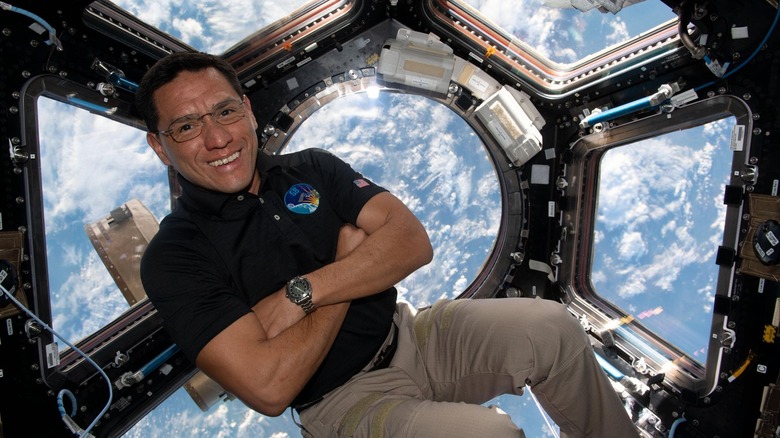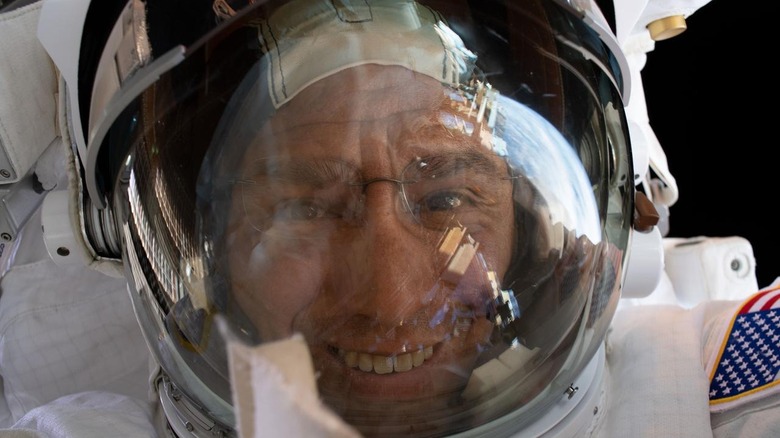How This NASA Astronaut Accidentally Broke A Space Record
Records are meant to be broken, but sometimes, they're done without any intention of ever doing so. Occasionally, those record-breaking accidents provide helpful insights that advance a particular field of science, such as how the human body reacts to long periods in space.
On September 21, 2022, NASA astronaut Frank Rubio and two Russian Roscosmos cosmonauts — Sergey Prokopyev and Dmitri Petelin — soared into space aboard the Soyuz MS-22. The craft launched from the Baikonur Cosmodrome in Kazakhstan and ferried the three occupants up to the International Space Station (ISS) for a six-month mission.
The Soyuz docked on schedule, and the astronauts went about their merry way to carry out their assigned duties. Things went according to mission parameters for about the first three months, but then, as the saying goes, "the best-laid plans of mice and men!"
On December 14, just as cosmonauts Prokopyev and Petelin were suiting up for a spacewalk, multiple coolant pressure sensors from the Soyuz (still docked to the ISS) began registering low readings within the cooling loop. Additional inspections discovered that the external radiator on the Soyuz had sprung a leak and spewed all its coolant into space. Russian space officials determined the leak was probably made by a micrometeoroid smaller than a grain of sand tearing through the radiator.
None of the astronauts were injured, and no other equipment was damaged, but the minute hole caused a monstrous problem, and the two space agencies immediately began working on a plan to get them back to Earth.
Houston, we have a record!
As luck would have it, the ISS had two spacecraft docked. Aside from the busted Soyuz, the SpaceX Crew Dragon — the first commercially crewed craft to dock at the ISS (in 2020) — was also there.
NASA and Roscomos decided a new Soyuz had to be sent up, which obviously couldn't happen overnight. So, an emergency interim plan was hatched in case the ISS crew had to evacuate. This "plan" involved strapping down a temporary seat inside the Crew Dragon ... with tie-downs. Frank Rubio would ride the rails in the SpaceX, while Sergey Prokopyev and Dmitri Petelin returned in the damaged Soyuz. But not without danger as temps could reach as high as 122 degrees Fahrenheit during re-entry.
Fortunately, no one had to fly home by the seat of their pants (on fire), but it did continue the clock on Rubio's extended stay on the ISS. On February 25, 2023, the Soyuz MS-23 arrived. What didn't come with that new spacecraft was a relief crew, which wouldn't be ready until the Soyuz MS-24 was ready.
And that day is finally (almost) here. The Soyuz MS-24, complete with a new crew comprised of NASA astronaut Loral O'Hara and Roscosmosnauts Oleg Kononenko and Nikolai Chub — is scheduled to launch on Friday, September 15, 2023. If all goes according to plan (and we all know how well that's gone so far), Rubio will return on September 27, having spent 371 days in space, making it not only the most extended continual mission by a U.S. astronaut but the first to spend over a year in space.
In space, no one can hear you working out
By the time Frank Rubio returns, he will have personally conducted several experiments to see how his own body reacted physiologically and psychologically to limited exercise using a bicycle and weightlifting machine on the ISS. They also customized a special diet focused on fruits, vegetables, and fish loaded with nutrients to see if it helped his body adapt to his time in space. The results are of particular importance for the upcoming 140 million-mile mission to Mars, which takes approximately nine months for a one-way trip.
And since they're not about to go all the way to the Red Planet, do a quick drive-by, and head home, astronauts will be in zero-G for a very long time. The trip there and back will take more than 18 months (or 548 days), which in and of itself is more than 100 days longer than the current record.
NASA astronaut Mark Vande Hei set the previous American record at 355 days, which Rubio broke on September 11 (of all days). Rubio does not hold the world record. though. That distinction goes to Russian cosmonaut Valery Polyakov, who amassed 437 days straight.
Once a flight surgeon, Rubio knows it will take some time for his body to adjust. "It might take a couple of days before I'm somewhat normal, but the reality is it's going to take anywhere from two to six months of really intense rehab to get back to my normal, and that's just part of the process."

